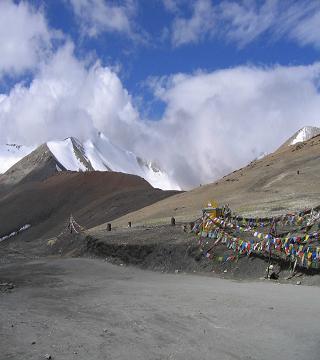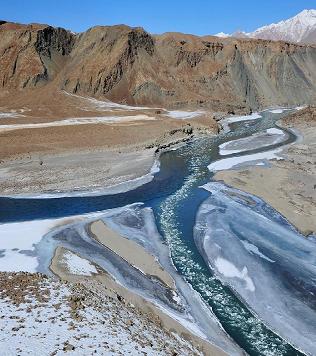
Welcome |
|
|
|
|
|
|
|
|
|
|
|
|
|
|
|
|
|
|
|
|
|
|
|
|
|
|
|
|
|
|
|
|
|
|
|
|
|
|
|
|
|
|
|
|
|
|
|
|
|
|
|
|
|
|
|
|
|
|
|
|
|
| |
|
|
|
|
Information about
Suru Valley |
|
The Suru Valley
is one of the most beautiful areas of Ladakh and a rather recent addition to the tourism map
of Ladakh. This valley runs for 140 km beyond Kargil to the Penzi la pass which is the
entry point into
the Zanskar Valley. The hills of Suru Valley are cultivated intensively than anywhere else in Ladakh.
Enough snow and water during the winters and fertile land makes it possible to yield two crops annually. The valleys are
especially picturesque in spring when the apple, apricot and mulberry trees are all in bloom and in autumn when they are laden with fruits.
At Thangbu, a little village, the traveler gets a
first glimpse of the spectacular Nun (7135 m) –
Kun(7935m) massif. Pahikhar, about 12 kms. away is the
base for treks to Kashmir and Kishtwar. The road goes
past the glaciers of the Nun-Kun massif
to descend to Rangdum gompa with a little stream
forming a moat around it, looks like |
 |
|
an ancient fort
protecting the valley. Only the basic accommodation is
available at most of the tourist spots of Suru Valley.
Sankoo, Panikhar, Rangdum and Padm in the Suru and Zanskar Valleys are the base for a variety of
trekking routes. The Suru Valley covers the catchment area of the famous Suru River. Suru river originates
from the Panzella glacier. Before it joins the Indus River at Nurla
it is joined by numerous tributaries, including the Dras River at Kharul.
Suru Valley forms the mainstay of Kargil district. The valley is nestled along the north-eastern foothills of the Himalayan range and from Kargil. People living
in Suru Valley are mainly of Tibet and Darad descent - most of them converted their religion in the 16th century.
The beauty of this Suru Valley region is further added by two towering peaks of Kun (7035 m) and Nun (7135 m) which loom over the skyline.
The general topography and mountains in most of the areas in Ladakh
differs from the Suru Valley as Suru Valley is relatively more fertile extending from
the Panzella glacier to south of Kargil town. In Kargil the Suru River merges with the Botkul River which originates from the Botkul
glacier.
The average altitude of the Suru valley is 3,000 m. Winters are extreme and heavy snowfalls are normal. Still the conditions in the Suru Valley do not
become as adverse in as the Dras Valley. The winters begin around mid-November and end in May. During
winter, most of the valley is covered with a thick
layer of snow. The interesting development can be observed as the water starts melting in the month of may. During
the first melting process one can see the dark color which is obtained by the water and after it takes the
blue and green colour. In the month of September
the water reflects the best color and at the same time as it starts getting cooler again the melting of the snow is
also slowed down thus water quantity becomes less. One of the factor that the Suru Valley is fertile if
compared with the other parts of Ladakh is that summer lasts here longer than in other parts.
Agriculture is the main activity of the local economy and also the main source of income for local people of the valley.
In some parts of the valley two crops can be yielded each year unlike in other parts of Ladakh where sometimes it is difficult to have even a single crop in the year. Main crops of the Suru
Valley are wheat, barley and millets. Some initiatives have
been taken to improve the wheat quality which has increased
the production of cereals. Some of the vegetables grown here
are turnip, radish, peas and black peas. Grapes, apricots and melons are produced in fairly large quantities at Darchik
and Garkoon along the lower course of the Indus through Ladakh. These find a ready market in Kargil. Liquor is made from grapes. |
|
|
|
|
|
Mulbekh village
|
|
After crossing the Suru valley, the road leads through a sandy plateau followed by another narrow valley and than one reaches
to Mulbekh village, which has
an important monastery on a high rock. The main attraction of Mulbekh is a 9 m high rock sculpture in deep relief of Maitreya, the Future Buddha. Here the
religion dates back to the period when Buddhists missionaries came travelling east of the Himalayas.
After reaching Mulbekh, one crosses Namika-La pass situated at a height of 12,000 feet. Later, the road leads
to the highest pass on the Srinagar-Leh Road known as Fatula,
about 13,497 feet above sea level. |
|
|
|
|
Kargil |
 |
Kargil is situated at an altitude of 204 kms from Srinagar in the west and 234 kms from Leh in the east.
Kargil is the
second largest urban centre of Ladakh and headquarters of the Kargil
district. Kargil is situated in
Suru Valley where the Suru river flows and meets the Indus at a place called Marul. A quite town now,
Kargil once served as an important trade and transit centre in the Pan-Asian trade network
that leads to Kashmir, Balitistan, Afghanistan, Central Asia
and Tibet.
Even after 1949, when the central Asian trade was ceased and trade was not taking place any more
through the old caravan route, the goods like silk, brocade, carpets, felts, tea, poppy, ivory were available in the local market. Kargil is the
second largest town in Ladakh after Leh and it is like an mid way point on the long journey from Srinagar to
Leh. Kargil is |
|
also the main take off point for excursions and
trekking into the Suru Valley and to the
area of Zanskar Valley with their exciting opportunities for mountaineering, camping, river rafting and trekking
trails into Himachal Pradesh, Jammu and the Indus Valley. The town is rather
conservative and highly dominated by Balti Shia Muslim culture and has two mosques built
in the Turkish style.
Being a part of Suru Valley, Kargil is green and the hill sides are richly cultivated.
The two tributaries of the River Suru, the Drass and Wakha meet at Kargil. There are pretty walks around the town with breathtaking
views of the mountains. There are only few villages in this valley at a height of 9000 feet. The valley has less
snow in winter and the ultra-violet rays are stronger as compared to other parts of Ladakh. This explains also
the abundance of fruit trees, like mulberry and apricot. Willows and poplars can also be seen at the
water courses.
For the tourists who start their journey in Srinagar by road it becomes mandatory after a tortuous drive to have a stop at Kargil, the second largest town of
Ladakh. To cater for the demanding and luxury tourists there are not enough good
hotels but many small establishments are available.
The broad area of Kargil and its wide terraces are separated from the Mulbekh valley by the 12 km long Wakha Gorge. Many of the trekking expeditions
starting from Kargil lasts for 7 to 12 days. The mountaineering excursions
are also organized to climb the Nun and Kun, both over 7,000 meter high.
On the Kargil – Leh road there is a picturesque village Shergol situated in the Wakha River valley. The
main attraction of this village is a cave monastery which is visible from quite far. The village is approachable
by a motorable road from the main Kargil-Leh road, almost 5 kms prior to Mulbek. Shergol is
also base for the 4 days trek across the mountain range into the Suru
valley. |
|
|
|
|
|
How to reach Suru Valley |
|
The ideal way to reach Suru Valley is via Kargil. One has to make the point to reach first Kargil. A bus or car ride takes around 2 to hours to Sankoo, 3
hours to Panikhar and about 4 hours to Parkachik. |
|
|
|
|